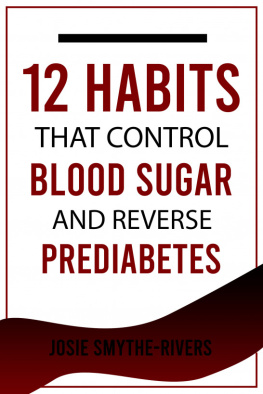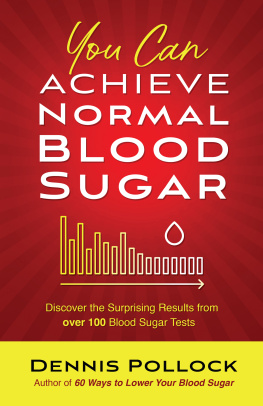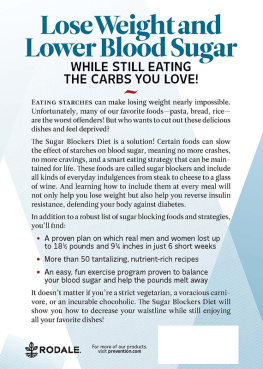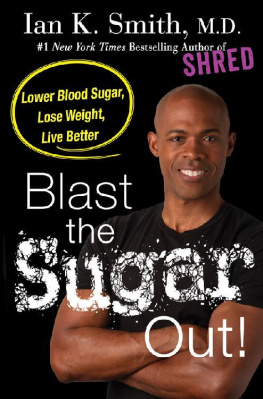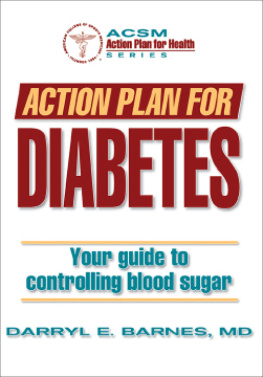12 Habits that Control BloodSugar and Reverse Prediabetes
Josie Smythe-Rivers
Copyright 2019 Josie Smythe-Rivers
All rights reserved
No part of this publication may be reproducedor transmitted in any form or by any means, electronic ormechanical, including duplication, recording, or any informationstorage and retrieval system except in the case of brief quotationsin critical reviews and certain other noncommercial uses permittedby copyright law.
Limit of Liability/Disclaimer of Warranty
The author makes no representation orwarranties with respect to the accuracy or completeness of thecontents of this work and specifically disclaims all warranties,including without limitation warranties of fitness for a particularpurpose. This book is intended as general information and shouldnot be used to diagnose, treat or manage any health condition.Because any health condition is individual and complex andspecific, this book is not intended to serve as, or replace,trained professional medical or dietary advice and treatment. Thiswork is sold with the understanding that the author is not engagedin rendering medical, dietary, legal, or other professional adviceor services. The ideas, information, procedures, suggestions, andanalyses in this book are intended to be used for informationalpurposes only. Consult with your professional health care providersand physicians before adopting or utilizing any of the suggestionsor information in this book as well as about any medical conditionthat might require medical attention, diagnosis, or treatment. Theauthor is not a medical professional and disclaims any liabilityarising directly or indirectly from the use of this book. Theauthor assumes no responsibility for personal injury, loss, ordamage that may result from the suggestions or information in thisbook. The fact that an individual, organization, website, orindustry is referred to in this work as a citation does not meanthe author endorses the information the individual, organization,website or entity may make. Readers should be aware that anywebsites listed in this book could change at any time.
Introduction to the 12 Habits
This is a quick start guide for those withelevated blood sugar or prediabetes as well as for those who wouldlike to keep their normal blood sugar from rising. This guide isalso useful for those with Type 2 diabetes who would like a quickset of reminders about diet and exercise that are proven to lowerblood sugar.
As a diagnostic category,prediabetes provides us with a vital window of time in which toreverse high blood sugar (intermediate hyperglycemia) usinglifestyle changes that are proven to be more effective than medication,lifestyle changes that can prevent the conversion of prediabetes todiabetes. Prediabetes brings with it serious adverse consequencesincluding cardiovascular disease; yet, it does not need to progressto diabetes. Prediabetes can be reversed and in many cases so canType 2 diabetes.
From a metabolic perspective, prediabetes isthe preliminary stage of Type 2 diabetes, but technically,prediabetes is a diagnostic category not a disease. Type 2 diabetes(and prediabetes) is primarily a dietary disease worsened by lackof movement (moderate exercise), too much stress, and sleepdeprivation. Genetic predisposition plays a role within families aswell as within specific populations in the development ofprediabetes and diabetes, and if you have a genetic predispositiontoward high blood sugar, controlling your diet, exercise, stresslevels, and sleep gives you enormous power in managing your bloodsugar.
High blood sugar andprediabetes absolutely can be reversed, and lifestyle changes areactually more effective than the first-line therapy, Metformin, which is an oraldiabetes medication. If you have elevated blood sugar orprediabetes, taking advantage of this window of time beforeprediabetes becomes diabetes is extremely important. Type 2diabetes can also be reversed, but it is more challenging andcomplicated to do so, and you should do so under supervision ofyour professional medical team.
In addition to genetics,many factors contribute to high blood sugar, prediabetes, anddiabetes, which are all stages on a continuum. Obesity and poornutrition, which often occur together, are primary factors. Obesityis pervasive in the U.S. and increasing globally. Age is anincreased risk factor for high blood sugar, prediabetes, anddiabetes. Yet high blood sugar can be a problem up to 20years before itshows up on an A1C test, which essentially measures high glucosepooling up in the blood after the body is no longer able storeit as fat in theorgans and tissues. The HbA1C test measuresthe problem downstream , not at the source,which is insulin resistance. Prediabetes and diabetes symptoms ofan underlying problem: insulin resistance.
Risk of prediabetes riseswith age, especially after age 45, but this risk of age is partlydue to the way we test and when we test; typically we dont seehigh blood sugar until there are already problems going on as the body tries to cope with excess intake of dietary carbohydrate, lack of exercise,stress, and sleep deprivation. Theseproblems include insulin resistance, fat storage (weight gain),high blood pressure and high cholesterol, high triglycerides, andlower levels of high-density lipoprotein(HDL) cholesterol (the good cholesterol) ,all of which are the result of too much blood glucose gettingstored as fat.
How we measure something affects the results.This is as true in nutrition as it is in physics. High blood sugarcauses problems long before prediabetes shows up in an A1C test.Thus, risk seems to rise with age in part because the underlyingproblem, insulin resistance, doesnt show up in an A1C test, butwere not routinely screening for insulin resistance despite theepidemic of metabolic health problems in this country. The outcomeof insulin resistance, high blood sugar, eventually does show up inthe A1C test. Therefore, if you have high blood pressure, or highcholesterol and high triglycerides, lower levels of HDLcholesterol, and weight gain, your body is struggling to cope withexcess dietary carbohydrateincluding natural and processed sugaras well as artificial sweeteners. Eventually this process is likelyto result in a high A1C test.
The diagnosis of prediabetes or diabetes viathe A1C test is the last stop on the train so to speak; damage dueto high blood sugar is already going on before that high bloodsugar shows up in the A1C test. The reason for this is that thebody is doing its best to cope by storing all that excess bloodglucose as fat. Yet, this process is reversible, and you can getoff this train.
This quick guide is designedto get you off the high-blood-sugar train long before the laststops, prediabetes and diabetes. Modern medicine treats diseases,not normal test results. There is no need to treat something thatisnt wrong according to the tests weuse , which makes sense logically.Again, how we measure things affects theresults and determines what is a disease.
Typically MDs dont chooseto test insulin resistance directly, which is the problem thatdrives high blood sugar. This can be done with a 2-HourInsulin Glucose Challenge Test. Instead,our medical system chooses to wait until glucose has piled up inthe blood, and even then 90% of prediabetics dont know they havehigh blood sugar or insulin resistance.
According to currentguidelines, A1C below 5.7% and appropriate fasting glucose testsmeans your blood sugar is normal. Yet, given that prediabetes anddiabetes are the result of high blood sugarand insulin resistance over time , i.e. acumulative process, we need to take the steps to ensure we dontget to that point. I say we because 80+ million adults in theU.S. have prediabetes. 80+ million people didnt mysteriously getto this last stop on prediabetes/diabetes the train without goingthrough the long process of rising blood sugar thatremains largely invisible because were testing (A1C) downstreamfrom the problem, insulin resistance.
Next page
